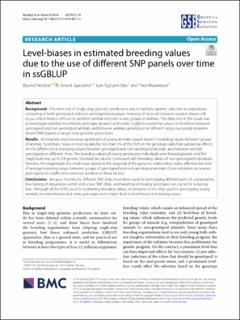| dc.contributor.author | Nordbø, Øyvind | |
| dc.contributor.author | Gjuvsland, Arne Bjørke | |
| dc.contributor.author | Eikje, Leiv Sigbjørn | |
| dc.contributor.author | Meuwissen, Theodorus | |
| dc.date.accessioned | 2020-07-28T11:37:09Z | |
| dc.date.available | 2020-07-28T11:37:09Z | |
| dc.date.created | 2020-01-30T12:39:44Z | |
| dc.date.issued | 2019 | |
| dc.identifier.citation | Genetics Selection Evolution. 2019, 51 . | en_US |
| dc.identifier.issn | 0999-193X | |
| dc.identifier.uri | https://hdl.handle.net/11250/2670317 | |
| dc.description.abstract | Abstract Background: The main aim of single-step genomic predictions was to facilitate optimal selection in populations consisting of both genotyped and non-genotyped individuals. However, in spite of intensive research, biases still occur, which make it difficult to perform optimal selection across groups of animals. The objective of this study was to investigate whether incomplete genotype datasets with errors could be a potential source of level-bias between genotyped and non-genotyped animals and between animals genotyped on different single nucleotide polymorphism (SNP) panels in single-step genomic predictions. Results: Incomplete and erroneous genotypes of young animals caused biases in breeding values between groups of animals. Systematic noise or missing data for less than 1% of the SNPs in the genotype data had substantial effects on the differences in breeding values between genotyped and non-genotyped animals, and between animals genotyped on different chips. The breeding values of young genotyped individuals were biased upward, and the magnitude was up to 0.8 genetic standard deviations, compared with breeding values of non-genotyped individuals. Similarly, the magnitude of a small value added to the diagonal of the genomic relationship matrix affected the level of average breeding values between groups of genotyped and non-genotyped animals. Cross-validation accuracies and regression coefficients were not sensitive to these factors. Conclusions: Because, historically, different SNP chips have been used for genotyping different parts of a population, fine-tuning of imputation within and across SNP chips and handling of missing genotypes are crucial for reducing bias. Although all the SNPs used for estimating breeding values are present on the chip used for genotyping young animals, incompleteness and some genotype errors might lead to level-biases in breeding values. | en_US |
| dc.language.iso | eng | en_US |
| dc.rights | Navngivelse 4.0 Internasjonal | * |
| dc.rights.uri | http://creativecommons.org/licenses/by/4.0/deed.no | * |
| dc.title | Level-biases in estimated breeding values due to the use of different SNP panels over time in ssGBLUP | en_US |
| dc.type | Peer reviewed | en_US |
| dc.type | Journal article | en_US |
| dc.description.version | publishedVersion | en_US |
| dc.source.pagenumber | 8 | en_US |
| dc.source.volume | 51 | en_US |
| dc.source.journal | Genetics Selection Evolution | en_US |
| dc.identifier.cristin | 1786299 | |
| dc.relation.project | Norges forskningsråd: 256321 | en_US |
| dc.relation.project | Norges forskningsråd: 255297 | en_US |
| cristin.unitcode | 192,10,1,0 | |
| cristin.unitname | Institutt for husdyr- og akvakulturvitenskap | |
| cristin.ispublished | true | |
| cristin.fulltext | original | |
| cristin.qualitycode | 2 | |

